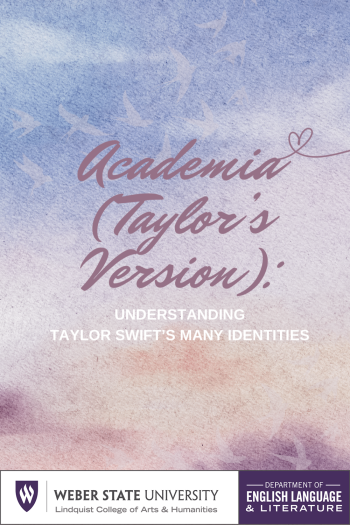Book Title: Academia (Taylor’s Version): Understanding Taylor Swift’s Many Identities
Edited by Justine Saxton

Download this book
Book Description: This book explores the many identities of Taylor Swift, a pop cultural icon and superstar who has been roundly praised and heavily criticized. She has become a familiar name to almost everybody worldwide, and her fans are often ardent and dedicated. The chapters are written from a critical perspective, looking at how she started her career as a girl; this innocent persona has laid a foundation for her career. As she has aged, Swift has become more outspoken about feminism, LGBTQ+ rights, and U.S. politics. She is also seen as a skilled business woman. Her work is intricate and often compared to poetry, and she engages in songwriting about love and relationships most often, lending to comparisons with other love poets and confessional poetry. We explore these themes, along with ideas about Swift’s interactions with racial politics and how she has become a subject of study in higher education. Lastly, this book makes a case for why studying Swift in higher education makes sense and how her fame highlights the way women and what they like is often criticized due to misogyny. Overall, the chapters of this book investigate the themes and controversies surrounding Swift from many identities and cultural frames.
Contents
Book Information
Book Description
This book explores the many identities of Taylor Swift, a pop cultural icon and superstar who has been roundly praised and heavily criticized. Questions surrounding Swift’s cultural impact are varied, and each chapter addresses those from a different frame. We unpack questions of identity and culture, focusing on critical approaches to girlhood, what it means to be a fan, feminism, queer allyship and identity, politics, business, poetry, race, relationships, and education.
In terms of girlhood, discussed in Chapter 1, we ask what it means to be an “all-American girl” and examine how carefully Swift cultivated that image as a young artist. Can any girl be all-American? Who is left out of images of girls as perfect, virginal, and obedient? And what do these ideas around girlhood do to the girls who hear them? In being a fan, explored in Chapter 2, we examine levels of commitment to Swift and question the authenticity of it. Are we enamored with a real person, or is she a master marketer and/or a brand? Further, what does it mean to be in a cult, and are critiques of Swift as a cult leader valid? In Chapter 3, we cover discourses of feminism surrounding Swift and how her feminism is considered to be too focused on white women and normativity, excluding women of color, global women, and queer women. We also wrote about Swift’s persona as a queer ally, and these discussions are outlined in Chapter 4. We define what it means to be an ally and how social justice concerns surrounding those we love might be more pressing than a simple music video could address.
We also explore Swift’s public political involvement in Chapter 5. Should public figures without particular qualifications get involved in politics? What effects does this have on fans? We examine celebrity influence, Swift’s political stands, and who gets to speak up when it comes to politics. Because Swift is a savvy business woman and much of her success can be attributed to her work in negotiating and marketing, we discuss questions of authenticity and capitalism in
Chapter 6. Are all of the stories and songs we know about Swift’s life true? Or, are they an image she wants us to believe? How does knowledge about business strategy affect the way we consume media, from any celebrity? Public images are carefully crafted to reach particular audiences.
Examining Swift’s work as poetry is outlined in Chapter 7. We look at her work as a mode of the confessional and found that Swift’s writing is not only confessional, but that some of it functions as a form of protest. She has protest songs (such as “Miss Americana and the Heartbreak Prince”) that remind us of the great tradition of protest novels. How do these songs function and create informed fans? In Chapter 8, we ask questions about race and Swift’s reinforcement of whiteness through her persona. How can she most ethically represent the many cultural styles of dance, music, and beat that she uses in her music and videos? What are some of the complications of those videos? Not only were we concerned with the ethics surrounding Swift’s use of images and words, but we recognize that many artists of color do similar work in terms of protest.
When it comes to love and relationships, covered in Chapter 9, we examine the age-old question of whether or not public figures should be allowed to have private lives. And, if a public figure writes about their private life in order to release an album, does that make it fair game for critique? In Chapter 10, we look at Swift as an educator because she has become the subject of many courses in higher education and community events. We trace the success of Swift-themed classes and events to Gen Z’s loneliness and attempt to understand how her cultural impact connects people and addresses social problems. With all of the many themes we can untangle based on Taylor Swift, the most important question we can ask in studying her is this: What can we learn? This is what this book is about, and it outlines the many ideas and themes surrounding Swift as a text for analysis. We found Swift to be a compelling figure and that her songwriting offers many avenues for critique and engagement. This book attempts to start vital conversations around the many facets of Swift’s persona, music, and talent.
License
Academia (Taylor’s Version): Understanding Taylor Swift’s Many Identities Copyright © 2024 by Emily January is licensed under a Creative Commons Attribution-NonCommercial-NoDerivatives 4.0 International License, except where otherwise noted.
Subject
The Arts

